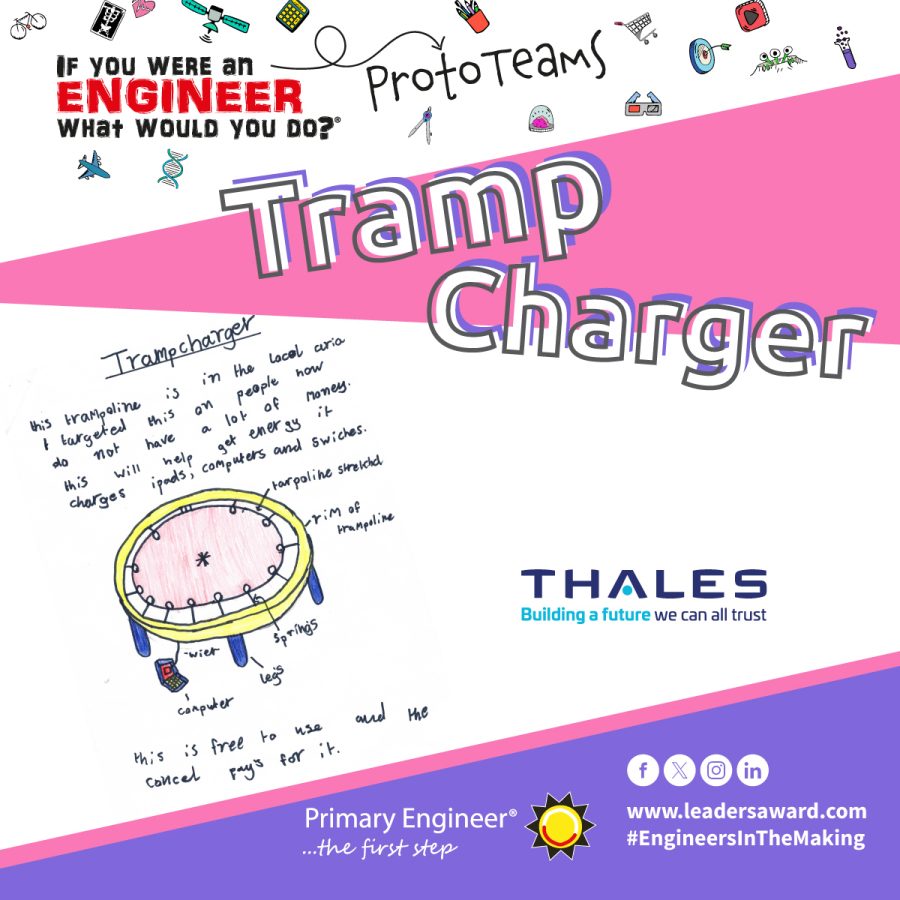
Thales Glasgow creating the Trampcharger prototype
Thales UK are a national partner for our Leaders Award competition which asks pupils aged 3-19 the question “If you were an engineer, what would you do?”. This year Thales UK will be creating 6 prototypes across 5 of their UK sites, in total turning 6 pupils’ ideas submitted to our Leaders Award competition into a working prototypes over the 2024/2025 academic year.

Pupil designer, Adam, will see his engineering idea ‘Trampcharger’ turned into a reality by Thales Glasgow. His idea is a device-charging trampoline that generates electricity when bounced upon and he wants to make this fun and exciting product available to all, for free, in the local park.
Introduction to the ProtoTeam
The team that shall endeavour to produce this creation is made up of six members of our Early Careers Community – three graduates and three apprentices. The graduates are Tom Warburton (Systems Engineer), Sakaria Sallah (Systems Engineer) and Jamie Read (Bid & Project Manager), while our apprentices are Neave Kelly (Manufacturing), Darcy Weatherby (Technical Publications & Training) and Connor Scott (Obsolescence). They are very excited to take on this challenge, and feel they have a good variety of skills and knowledge to make this a success.
Why did they choose this idea to build?
There were a variety reasons that ‘Trampcharger’ was selected, many of which directly targeted modern day societal needs or vitally important topics. The concept presents a unique fusion of play and functionality – by harnessing the kinetic energy generated from the physical activity, this innovation promotes an active lifestyle, which is vitally important considering that 15% of children aged 2-15 are obese (Health Survey for England 2022) and 64% adults are either overweight or obese.
Another major reason for selection was the obvious focus on the environment and renewable energy. Adam himself repeatedly mentions the positive environmental factors of the design, pointing out the charger “uses green energy, the best energy for the environment”. This creation fosters awareness by encouraging people to engage with sustainable practices and think about renewable energy, all while making energy generation fun. The environment and global warming are major topics that are the focus of governments and organisations around the world, so it is great to see such an interest on this from Adam.
The convenience of the idea was another attractive aspect to Adam’s proposal, allowing users to charge their devices during outdoor recreational activities, seamlessly integrating leisure and technology. Furthermore, the design has significant potential for evolution, not just for this particular apparatus, but for an entire playground. The potential for adding mini-wind turbines to the top of the swings or turning the roundabout into a turbine is there, just needs refining. Essentially any moving part of a playground could evolve to produce energy.
Starting the prototype – planning
The team currently have two potential solutions with which we are moving forward into our testing phase with. One option is to create a ring of piezoelectric discs around the frame of the trampoline. When someone bounces on the trampoline and creates vibrations, these discs produce a small amount of electricity. By having a large number of these small discs all around the trampoline, we may be able to generate enough electricity to charge a device.

The second solution involves creating motors using springs and magnets. A magnet is wrapped in a coil and attached to a spring at both ends. As the trampoline is used, the magnet will pass horizontally through the coil as springs expand and contract, creating an EMF. Wires will be connected to the coil, feeding the electricity straight to the battery pack for charging.

Next steps
The next stage of our project is the testing phase. The team will be testing the two different solutions in a number of ways and under a number of conditions. They will then continue experimenting with each option until they decide upon their final design for producing the most amount of electricity. They are also planning to visit Adam and his school, so they can get his feedback on our suggestions and ensure that he is thoroughly involved throughout the process.
We are looking forward to the next update!
